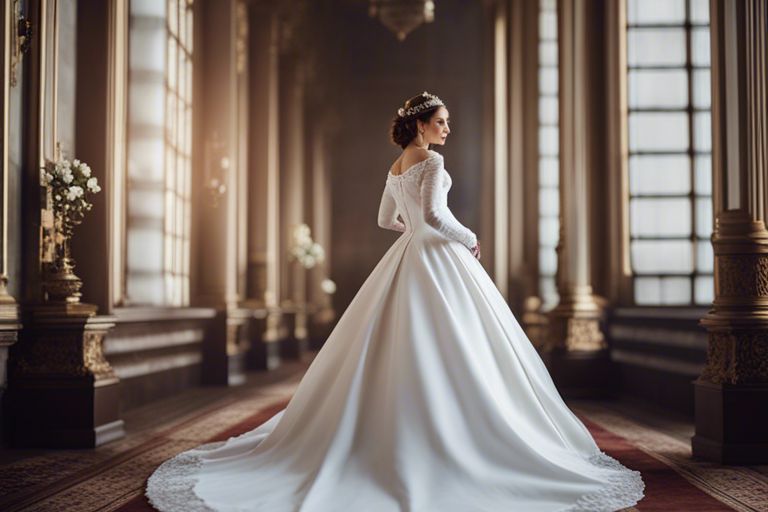As you research into fashion history, you may find yourself pondering the influential figures who have shaped the industry into what it is today. One such iconic figure is Queen Victoria, whose reign not only transformed the British monarchy but also left an indelible mark on the world of fashion. You may be surprised to learn that this beloved monarch was responsible for popularizing a particular trend that would go on to dominate the runways and streets for generations to come. And now, dear reader, it’s time to uncover the fascinating story behind the fashion trend that Queen Victoria so elegantly started.
The Reign of Queen Victoria
Before delving into the fashion trend that Queen Victoria started, it’s imperative to understand the era in which she reigned. You see, the Victorian era was a time of great change and transformation, and Queen Victoria’s influence extended far beyond fashion.
A Brief Overview of the Victorian Era
On the throne from 1837 to 1901, Queen Victoria’s reign marked a significant period in British history. It was an era of industrialization, urbanization, and imperial expansion, which saw the British Empire reach its zenith. You will find that this era was characterized by a growing middle class, advances in technology, and a renewed interest in the arts.
The Queen’s Influence on Society
The Queen’s influence on society was profound, and her impact was felt in every aspect of life, from politics to culture. You will discover that Queen Victoria’s values, beliefs, and tastes shaped the social norms of her time, and her influence extended to the farthest reaches of the empire.
Overview of Queen Victoria’s influence reveals that she was a monarch who took her role very seriously. She was a devoted wife, mother, and queen, and her strong sense of duty and morality guided her decisions. You will find that her influence was not limited to the aristocracy, but trickled down to the middle and lower classes, shaping their values and aspirations. Her reign was marked by a growing sense of national identity, and she played a significant role in promoting British culture and values around the world.
Historical Influence on Fashion
Delve into the historical roots of modern fashion trends and discover how figures like Queen Victoria shaped today’s fashion landscape. Explore the origins of certain styles and their enduring appeal through Emo Hair Fashion: Iconic Styles and Trends.
The Birth of a Fashion Trend
Clearly, Queen Victoria’s influence on fashion extended far beyond the borders of the British Empire. Her reign, which spanned over six decades, was marked by a profound impact on the way people dressed, particularly when it came to mourning attire.
The Rise of Mourning Attire
Around the mid-19th century, a peculiar phenomenon began to take shape in Europe and America. Mourning attire, once reserved for the bereaved, became a fashion staple, with people from all walks of life donning black clothing and accessories as a symbol of respectability and morality. You might wonder what sparked this somber trend, and the answer lies in the personal experiences of Queen Victoria herself.
The Queen’s Personal Experience with Mourning
Experiencing the devastating loss of her beloved husband, Prince Albert, in 1861, Queen Victoria was plunged into a state of deep mourning. Her grief was so profound that it influenced not only her personal style but also the entire nation’s approach to bereavement.
This tragic event marked a turning point in the Queen’s life, and subsequently, in the history of fashion. Her decision to wear mourning attire for the remainder of her life, a period of approximately 40 years, set a precedent for the aristocracy and eventually, the general population. You can imagine how the Queen’s unwavering commitment to mourning dress codes would have a ripple effect on the fashion world, ultimately giving rise to a trend that would dominate the Victorian era.
The Fashion of Mourning

Any glance into the fashion of Queen Victoria’s era would be incomplete without a discussion of mourning attire. During her reign, mourning dress was an crucial part of the grieving process, and the Queen herself played a significant role in popularizing this fashion trend.
The Tradition of Mourning Dress
Mournful as it may seem, the tradition of donning special attire to signify bereavement dates back to ancient times. In the 19th century, however, this practice reached new heights, with strict rules governing what was deemed appropriate for the grieving. You, dear reader, would have been expected to adhere to these guidelines, lest you be considered disrespectful to the deceased.
The Colors of Mourning: Black, Purple, and White
An array of somber hues characterized mourning dress, with black being the most ubiquitous. But did you know that purple and white also played important roles in this fashion tradition? Each color held significance, and you would have carefully selected your attire based on the stage of mourning you were in.
Black, of course, was the most severe and immediate color of mourning, worn during the initial stages of grief. As time passed, you might have transitioned to purple, a color associated with half-mourning, and finally, to white, which symbolized the end of the mourning period. This gradual shift in colors was a visual representation of your emotional journey, and you would have been keenly aware of the subtle nuances each hue conveyed.
The Accessories of Mourning: Veils, Bonnets, and Jewelry
Any lady worth her salt would have known that mourning attire extended far beyond clothing. You would have carefully selected veils, bonnets, and jewelry to complement your somber outfits, each piece designed to convey your respect for the deceased.
A delicate lace veil, for instance, might have been worn to signify your bereavement, while a jet brooch or a pair of black gloves would have added a touch of elegance to your mourning ensemble. These accessories were not mere trinkets; they were an integral part of the mourning ritual, and you would have chosen them with great care to ensure you were paying proper respects to your loved one.
The Queen’s Impact on Fashion

Not only did Queen Victoria popularize mourning attire, but her influence extended far beyond that, shaping the fashion landscape of her time.
The Popularization of Mourning Attire
With the death of her beloved husband, Prince Albert, Queen Victoria begined on a 40-year mourning period, during which she wore only black clothing. You, dear reader, may think this somber attire was a mere expression of grief, but it sparked a fashion phenomenon. Mourning wear became a staple in many women’s wardrobes, with black dresses, veils, and accessories becoming de rigueur.
The Influence on Women’s Fashion
Attire during the Victorian era was heavily influenced by the Queen’s personal style. You may have noticed that women’s fashion during this time was characterized by tight corsets, full skirts, and layers of petticoats. The Queen’s love for these silhouettes trickled down to the masses, making them a staple in many women’s wardrobes.
Fashion historians credit Queen Victoria with popularizing the concept of “separate spheres” – the idea that men and women had distinct roles in society. This ideology was reflected in women’s clothing, which emphasized modesty, domesticity, and femininity. You, dear reader, may be surprised to learn that the Queen’s influence extended beyond fashion, shaping societal norms and expectations.
The Creation of a New Industry
Impact of the Queen’s fashion sense was not limited to the aristocracy; it also created a new industry. The demand for mourning attire, as well as the elaborate dresses and accessories favored by the Queen, led to the establishment of fashion houses, textile mills, and accessory manufacturers. You, dear reader, may be interested to know that this boom in the fashion industry paved the way for the modern fashion landscape we know today.
Another significant consequence of the Queen’s influence was the rise of fashion journalism. With the growing interest in fashion, publications began to emerge, catering to the masses’ desire for style advice and news. You, dear reader, may be familiar with the likes of Vogue and Harper’s Bazaar, but did you know that they owe a debt of gratitude to Queen Victoria’s fashion legacy?
The Evolution of Mourning Fashion
Unlike the frivolous and extravagant fashion trends of the Victorian era, mourning fashion was a somber and restrictive affair. It was a reflection of the societal norms and etiquette of the time, where grief and bereavement were expected to be worn on one’s sleeve, quite literally.
From Restrictive to Liberated
Fashion, in the Victorian era, was a means of conveying one’s social status, and mourning fashion was no exception. You, as a mourner, were expected to adhere to a strict dress code, which included wearing black clothing, veils, and jewelry made of jet or other dark materials.
The Role of Etiquette in Mourning Fashion
On the surface, mourning fashion may seem like a mere expression of grief, but it was, in fact, a complex system governed by strict rules of etiquette. You, as a mourner, were expected to follow a specific protocol, which dictated the type of clothing you wore, the length of time you wore it, and even the way you wore your hair.
To fully understand the significance of mourning fashion, you must consider the societal norms of the time. In the Victorian era, death was a frequent visitor, and mourning was a public display of grief. The rules of etiquette surrounding mourning fashion were designed to show respect for the deceased, as well as to provide a sense of comfort and solidarity to the bereaved.
The Impact of World War I on Mourning Attire
An unprecedented number of deaths during World War I led to a shift in the way people mourned. You, as a mourner, were no longer expected to follow the traditional rules of mourning fashion, which were seen as outdated and impractical.
Liberated from the constraints of traditional mourning attire, you were free to express your grief in more subtle ways. The war marked a turning point in the evolution of mourning fashion, as people began to move away from the restrictive and elaborate customs of the past, towards a more modern and practical approach to mourning.
The Legacy of Queen Victoria’s Fashion Trend
To this day, Queen Victoria’s influence on fashion remains unparalleled. Her reign not only shaped the course of British history but also left an indelible mark on the world of fashion.
The Enduring Influence on Fashion
With her impeccable taste and sense of style, Queen Victoria set the tone for generations of fashion enthusiasts to come. You can still see echoes of her influence in modern bridal wear, where veils and lace continue to be popular choices.
The Revival of Mourning Fashion in Modern Times
For a brief period in the 2010s, mourning fashion experienced a resurgence, with designers incorporating elements of Victorian mourning attire into their collections. You may have noticed the subtle yet striking presence of black lace, veils, and intricate embroidery on runways and in fashion editorials.
Influence of this revival can be seen in the work of designers like Alexander McQueen and Jean Paul Gaultier, who drew inspiration from Queen Victoria’s iconic mourning style. Their designs not only paid homage to the past but also reinterpreted it for a modern audience, making mourning fashion accessible and desirable once again.
The Cultural Significance of Mourning Attire
Culturally, mourning attire serves as a poignant reminder of our shared human experience. It represents a universal language of grief, respect, and remembrance, transcending borders and eras. You, as a fashion enthusiast, can appreciate the emotional depth and historical significance that mourning attire embodies.
Revival of mourning fashion in modern times also highlights the cyclical nature of fashion trends. As you explore the world of fashion, you begin to realize that trends often revisit and reinterpret the past, breathing new life into forgotten styles and reviving cultural traditions. In this sense, Queen Victoria’s legacy extends far beyond her reign, influencing the way you think about fashion and its role in shaping our cultural identity.
Final Words
With these considerations, you now possess the knowledge that Queen Victoria, the epitome of elegance, single-handedly popularized the fashion trend of wearing black clothing during mourning periods. Your curiosity has led you to uncover a fascinating aspect of history, and for that, you should be commended. As you continue to navigate fashion, remember that even the most seemingly trivial trends often have a rich, storied past, waiting to be unearthed and admired.
FAQ
Q: What fashion trend did Queen Victoria popularize in the 19th century?
A: Queen Victoria popularized the fashion trend of wearing white wedding dresses. Before her time, brides typically wore colorful dresses for their weddings, but Queen Victoria’s choice of a white wedding dress for her wedding to Prince Albert in 1840 started a trend that has continued to this day. The Queen’s decision was influenced by her love of white flowers and her desire to showcase her wealth, as white fabric was difficult to clean and maintain at the time.
Q: Did Queen Victoria influence mourning fashion in any way?
A: Yes, Queen Victoria had a significant impact on mourning fashion during her reign. After the death of her husband Prince Albert in 1861, Queen Victoria went into a period of mourning that lasted for the rest of her life. She popularized the fashion trend of wearing black clothing and jewelry made from jet, a type of gemstone, during periods of mourning. This trend, known as “mourning attire,” became a social norm in Victorian England and was adopted by people of all classes.
Q: How did Queen Victoria’s fashion sense influence everyday women’s clothing?
A: Queen Victoria’s fashion sense had a profound influence on everyday women’s clothing during the Victorian era. The Queen’s love of tight-lacing corsets, bustles, and petticoats led to the widespread adoption of these items by women of all classes. Her influence also extended to the popularity of certain fabrics, such as silk and velvet, and the use of decorative elements like lace and embroidery. Additionally, the Queen’s preference for modest, high-necked clothing helped to promote a more demure and respectable image of women during this time period.





